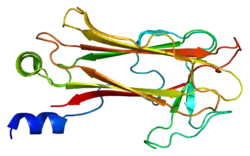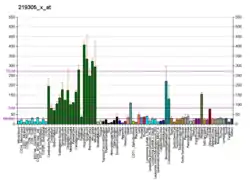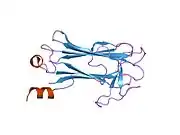FBXO2
F-box only protein 2 is a protein that in humans is encoded by the FBXO2 gene.[5][6][7]
This gene encodes a member of the F-box protein family which is characterized by an approximately 40 amino acid motif, the F-box. The F-box proteins constitute one of the four subunits of the ubiquitin protein ligase complex called SCFs (SKP1-cullin-F-box), which function in phosphorylation-dependent ubiquitination.
The F-box proteins are divided into 3 classes: Fbws containing WD-40 domains, Fbls containing leucine-rich repeats, and Fbxs containing either different protein-protein interaction modules or no recognizable motifs. The protein encoded by this gene belongs to the Fbxs class. This protein is highly similar to the rat NFB42 (neural F Box 42 kDa) protein which is enriched in the nervous system and may play a role in maintaining neurons in a postmitotic state.[7]
References
- GRCh38: Ensembl release 89: ENSG00000116661 - Ensembl, May 2017
- GRCm38: Ensembl release 89: ENSMUSG00000041556 - Ensembl, May 2017
- "Human PubMed Reference:". National Center for Biotechnology Information, U.S. National Library of Medicine.
- "Mouse PubMed Reference:". National Center for Biotechnology Information, U.S. National Library of Medicine.
- Cenciarelli C, Chiaur DS, Guardavaccaro D, Parks W, Vidal M, Pagano M (Dec 1999). "Identification of a family of human F-box proteins". Curr Biol. 9 (20): 1177–9. doi:10.1016/S0960-9822(00)80020-2. PMID 10531035. S2CID 7467493.
- Winston JT, Koepp DM, Zhu C, Elledge SJ, Harper JW (Dec 1999). "A family of mammalian F-box proteins". Curr Biol. 9 (20): 1180–2. doi:10.1016/S0960-9822(00)80021-4. PMID 10531037. S2CID 14341845.
- "Entrez Gene: FBXO2 F-box protein 2".
Further reading
- Erhardt JA, Hynicka W, DiBenedetto A, et al. (1999). "A novel F box protein, NFB42, is highly enriched in neurons and induces growth arrest". J. Biol. Chem. 273 (52): 35222–7. doi:10.1074/jbc.273.52.35222. PMID 9857061.
- Yoshida Y, Chiba T, Tokunaga F, et al. (2002). "E3 ubiquitin ligase that recognizes sugar chains". Nature. 418 (6896): 438–42. Bibcode:2002Natur.418..438Y. doi:10.1038/nature00890. PMID 12140560. S2CID 4424996.
- Ilyin GP, Sérandour AL, Pigeon C, et al. (2003). "A new subfamily of structurally related human F-box proteins". Gene. 296 (1–2): 11–20. doi:10.1016/S0378-1119(02)00867-3. PMID 12383498.
- Strausberg RL, Feingold EA, Grouse LH, et al. (2003). "Generation and initial analysis of more than 15,000 full-length human and mouse cDNA sequences". Proc. Natl. Acad. Sci. U.S.A. 99 (26): 16899–903. Bibcode:2002PNAS...9916899M. doi:10.1073/pnas.242603899. PMC 139241. PMID 12477932.
- Eom CY, Lehman IR (2003). "Replication-initiator protein (UL9) of the herpes simplex virus 1 binds NFB42 and is degraded via the ubiquitin-proteasome pathway". Proc. Natl. Acad. Sci. U.S.A. 100 (17): 9803–7. Bibcode:2003PNAS..100.9803E. doi:10.1073/pnas.1733876100. PMC 187846. PMID 12904574.
- Gerhard DS, Wagner L, Feingold EA, et al. (2004). "The status, quality, and expansion of the NIH full-length cDNA project: the Mammalian Gene Collection (MGC)". Genome Res. 14 (10B): 2121–7. doi:10.1101/gr.2596504. PMC 528928. PMID 15489334.
- Gregory SG, Barlow KF, McLay KE, et al. (2006). "The DNA sequence and biological annotation of human chromosome 1". Nature. 441 (7091): 315–21. Bibcode:2006Natur.441..315G. doi:10.1038/nature04727. PMID 16710414.






